Ambuya
(also Mbuya, chiShona) A female honorific title variously meaning grandmother, paternal aunt, mother-in-law, midwife. It is commonly used to show respect to an older woman whether or not she has borne any children. (Source)
Banya
Ritual round house, dedicated to the spirit [medium].
Beat
There are various common uses of the terms [musical] beat and pulse. Some use them interchangeably.
On matepe.org and symres.org we use beat as Gerhard Kubik and Andrew Tracey do: as the middle of three temporal reference levels Cycle – Beat – Pulse.
Beats are equidistant; they define the tempo and often also the anchor of movement of dancers. Each beat is divided into pulses (often 2, 3 or 4) that can be subject to recurring micro-temporal shifts (“groove”, “swing”).
The pulse (actually: elementary pulsation) is the smallest unit of musical pattern formation – although in drumming pulses are occasionally carried out as double, triple, or buzz strokes. However, these subdivisions are no longer the subject of patterns that may include rests.
Most matepe pieces have a cycle of 48 pulses, with four rhythmically strongly symmetrical phrases of 12 pulses each. These phrases often contain motifs in groups of 3 or 4 pulses, usually simultaneously. Where you anchor your sense of downbeat is up to the listener, and can lead to amazing kaleidophonic effects.
Bira
See Bira on Wikipedia.
chiShona
Shona language (in chiShona).
Deze
(Plural: Mateze)
The resonator used to amplify mbiras. Traditionally made from large gourds, today also from fiber and resin. The former easily break while the latter sound a bit more bucket-y. Mateze (plural) not only amplify the sound but also shorten the notes so that they sound more percussive.

Diwa area
The area within today’s Rushinga district, where Marymount mission is located, and Sekuru met his fellow matepe players.
Kuda Samora Nyaruwabvu notes: “I am sure the use of the name Diwa is more of the precolonial time. Then colonialism brought the political demarcations of districts. Like in the case of Mudzi and Mukota. Back then all used to fall under Mutoko but now they are separated.“
Dzimati
A Mhondoro from [close to?] Diwa area. A strong spirit, according to Sekuru Chawasarira.
Gomero
Chawasarira explains: “Gomero is the Korekore name for soundboard where the keys are fixed. The Zezuru name is Gwariva meaning the same thing.
Kukomera means to fix something onto something”.
According to Tatenda Cangola, the word Gomero carries a deeper meaning of lamentation; metaphorically the soundboard that carries the keys laments when they are pushed.
Gwariva
See Gomero.
Hosho
See Hosho on Wikipedia.
Hera / Heera
Regional variant of the matepe from Rushinga district, and further up north in Mozambique.
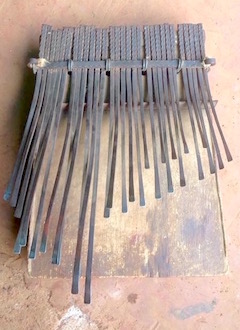
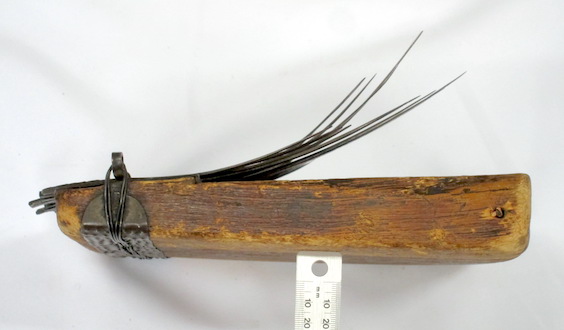
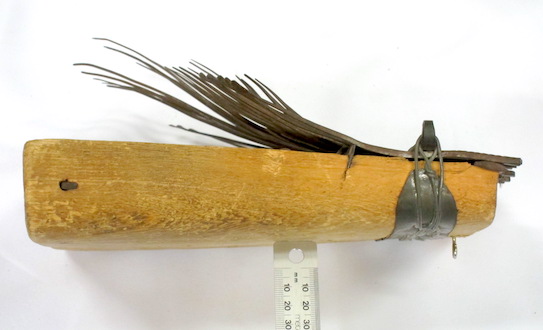
Kaleidophony
The phenomenon of hearing a (subjectively) different piece of music (in terms of rhythm, harmony, and tonal center), depending on where in the cycle you anchor your sense of downbeat.
For demonstration see Kaleidophony.
Madhebhe
Regional variant of the matepe from Mutoko and Uzumba-Maramba-Pfungwe (UMP) districts, sometimes with broader keys and a slightly shifted interlacement of the upper and lower left thumb ranks.
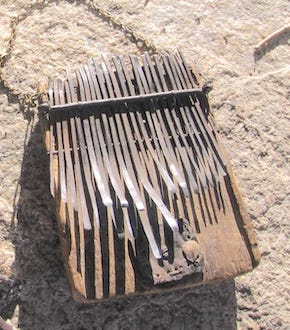
Magotokoto
“The he-goats” – name of the three left index keys and their counterparts in the right thumb manual (i.e. the two offset keys and the leftmost key in the lower rank).
Makukuba
“The basses” – name of the keys in the left thumb lower rank. (Though technically the rightmost Nhundura key is the second lowest bass)
Matepe
A now very rare type of mbira from the Northeast Zimbabwe and immediately adjacent areas in Mozambique that is the subject of this preservation project. Regional variants include the Hera and Madhebhe.
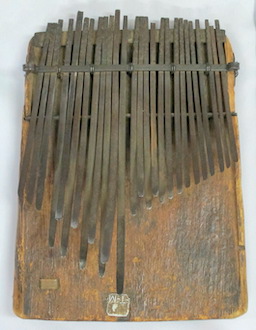
Zack Moon has written a nice introduction to matepe on mbira.org.
Find further information about purchasing an instrument and sound recordings on symres.org.
Mbira
(chiShona) Generic term for board lamellophone in chiShona.
Players of any type of mbira (like matepe, njari, karimba) often refer to their instrument just as “the mbira”, and use more specific names only when referring to other kinds of mbira.
The word “mbira” became known worldwide primarily through Paul Berliner’s ethnography The Soul of Mbira (first published in 1974 as a PhD thesis). Since then it has since often been equated with the mbira dzavadzimu outside Zimbabwe.
Mbira dzavadzimu
(chiShona) Mbira of the vadzimu. Also called nhare or mbira huru.
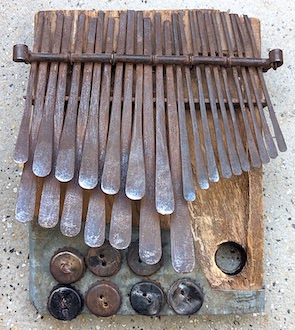
One of five major types of mbira in Zimbabwe, and probably the best known traditional mbira type within and outside the country today. Compared to the Matepe, there is no manual for the left index finger, and players require considerable virtuosity to create textures as dense as the matepe.
According to Chawasarira, all mbira types are “dialectical”, i.e. they originally came from different ethnic groups of what has been summarised under the collective term “Shona people” since colonial times. Matepe players from northeast Zimbabwe refer to the mbira dzavadzimu as the “Zezuru mbira”.
Historically, the geographical location of the Zezuru people in the region around the capital has certainly contributed to the international visibility and popularity of this particular mbira type, and its occasional equation with “mbira”.
The term “mbira dzavazdzimu” is somewhat controversial. It was introduced into academic literature by Hugh Tracey (“mbira dze midzimu”) and is used throughout by Paul Berliner, referring to his informant Mubayiwa Bandambira (who called it “mbira huru dzavadzimu”).
Some international mbira students avidly point out that “no mbira [dzavazimu] player” [they know] uses this term, while some Zimbabweans argue that the association with the vadzimu promotes prejudice on the part of fundamental Christians and is therefore detrimental to the cause of promoting mbira.
Personally, I (Stefan Franke) suspect that Tracey and Berliner primarily needed a term to differentiate this type of mbira from others, and therefore elevated what was rather meant as a praise name to the rank of a type designation, unaware of the anti-academic or religious resentment that could later evoke.
Mbirimiro
“the insulter” – name that Chawasarira gave to his topmost Nhundura extra key.
Mhenemene
“The goat kids” – name for the right index finger keys. Also called Nhetete.
Mhondoro
(chiShona) Lion. In our context: Lion spirit
Ancestral spirits of royal lineage, deceased chiefs and kings.
In Shona traditional belief system of Shona peoples, mhondoro spirits reside in the bodies of maneless lions until they found a medium to possess. Situated in the spiritual hierarchy between the vadzimu and gombwe spirits (those who have never been human beings; rain making spirits; who in turn reside right under mwari, the creator), the mhondoro are concerned with matters of their clans and territories, up to the entire nation.
Minor change
A term we use to denote variations of an mbira part, because Sekuru Chawasarira already uses the term variation differently.
Mudzimu
(Singular of vadzimu, chiShona)
Mushanguro
“The thrashed ones” – name for the higher keys in the right thumb lower rank (those which are not Magotokoto).
Nhare
(Metal, Telephone, chiShona) A popular way to refer to the mbira dzavadzimu.
Nhetete
Besides Mhenemene, another name for the right index finger keys, according to Chawasarira, meaning very high notes in Zezuru dialect.
Nhundura
Name of keys in the left thumb upper rank (Chawasarira: “The middle high ones”; “Kutunduruka means top or high so those top keys are nhundura played from the top”).
Nyahuye / Nyahuwe
A Mhondoro regularly referred to by Sekuru Chawasarira. A princess, daughter of a Monomotapa, she is the ancestor of the people of Diwa.
Pandutsa
(infinitive kupandutsa, imperative panduka, chiShona) A musical announcement of a matepe player to start playing, or change into a new part.
Part
On this page we use the term “mbira part” for a complete musical pattern that can be played by a single player for an unlimited period of time. Mbira pieces often have parts for multiple players that are rhythmically interwoven to form an intricate texture from which numerous inherent patterns emerge.
Parts can have variations, which we here call minor changes, because Sekuru Chawasarira already uses the term variation synonymously with parts.
Pulse
Also: elementary pulsation. See beat.
Sekuru
(chiShona) A male honorific title meaning grandfather, uncle, respected elder. Also used in a ceremonial context to refer to a person carrying a (male) mudzimu.
Shave
(plural mashave, chiShona)
A category of spirits in the traditional belief system of Shona peoples. Unlike the ancestral spirits (Vadzimu, Mhondoro), Mashave spirits are considered foreign or wandering spirits of neighboring peoples, Europeans or even animals. They can be benevolent or malicious. Benevolent Mashave are often viewed as the cause of individual talents, such as healing, music, or artistic ability.
Vadzimu
(singular mudzimu, chiShona)
A category of spirits in the traditional belief system of Shona peoples, referring to recent ancestors. They are considered benevolent and protect their descendants, but may withdraw this protection if moral ideals and ceremonial duties are not respected.
Variation
Sekuru Chawasarira uses the term variation to refer to mbira parts for different players, that often have an entirely different rhythmic patterns.
For this reason we use the term minor change for variations of a part that maintain its elementary structure.